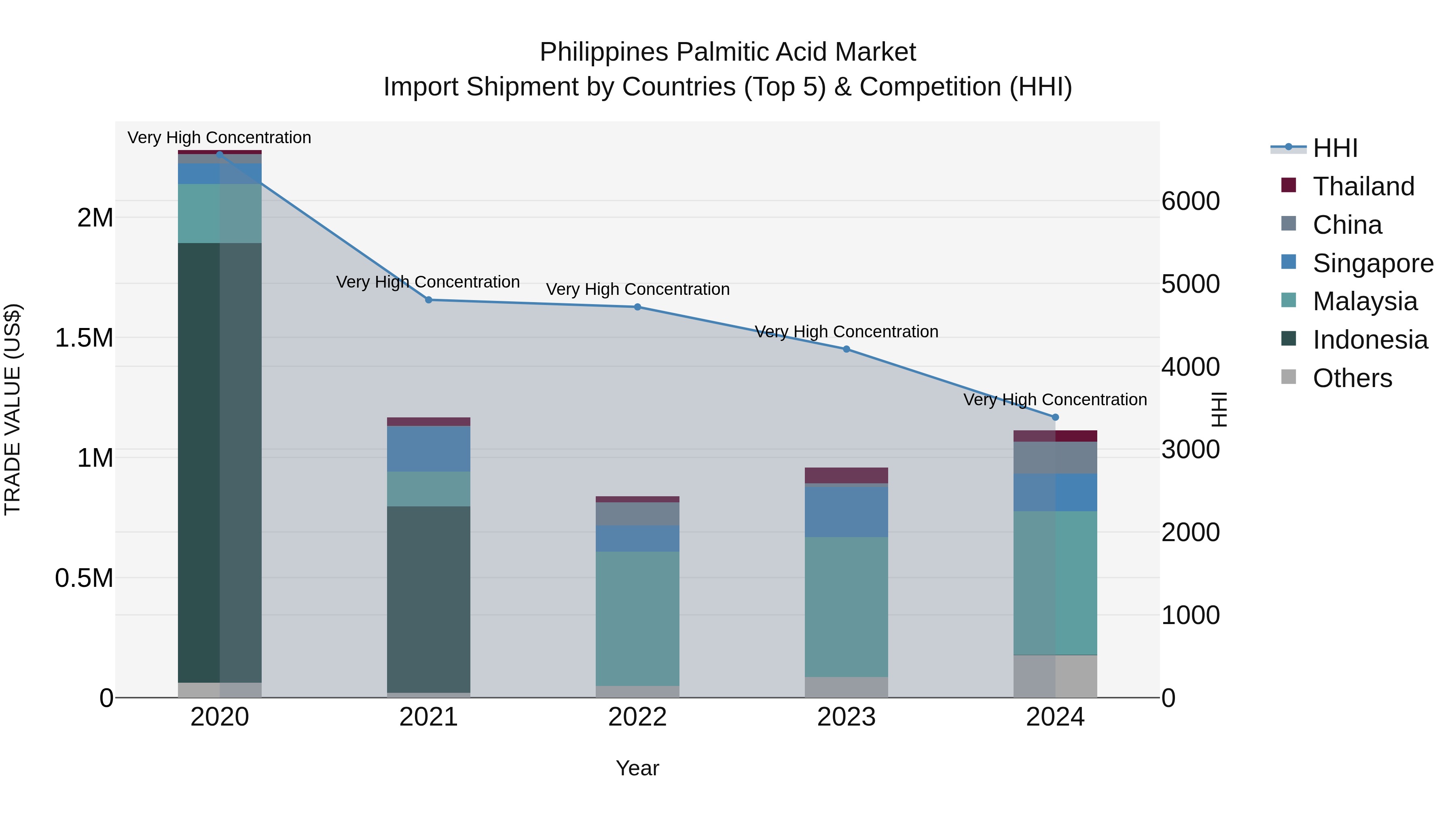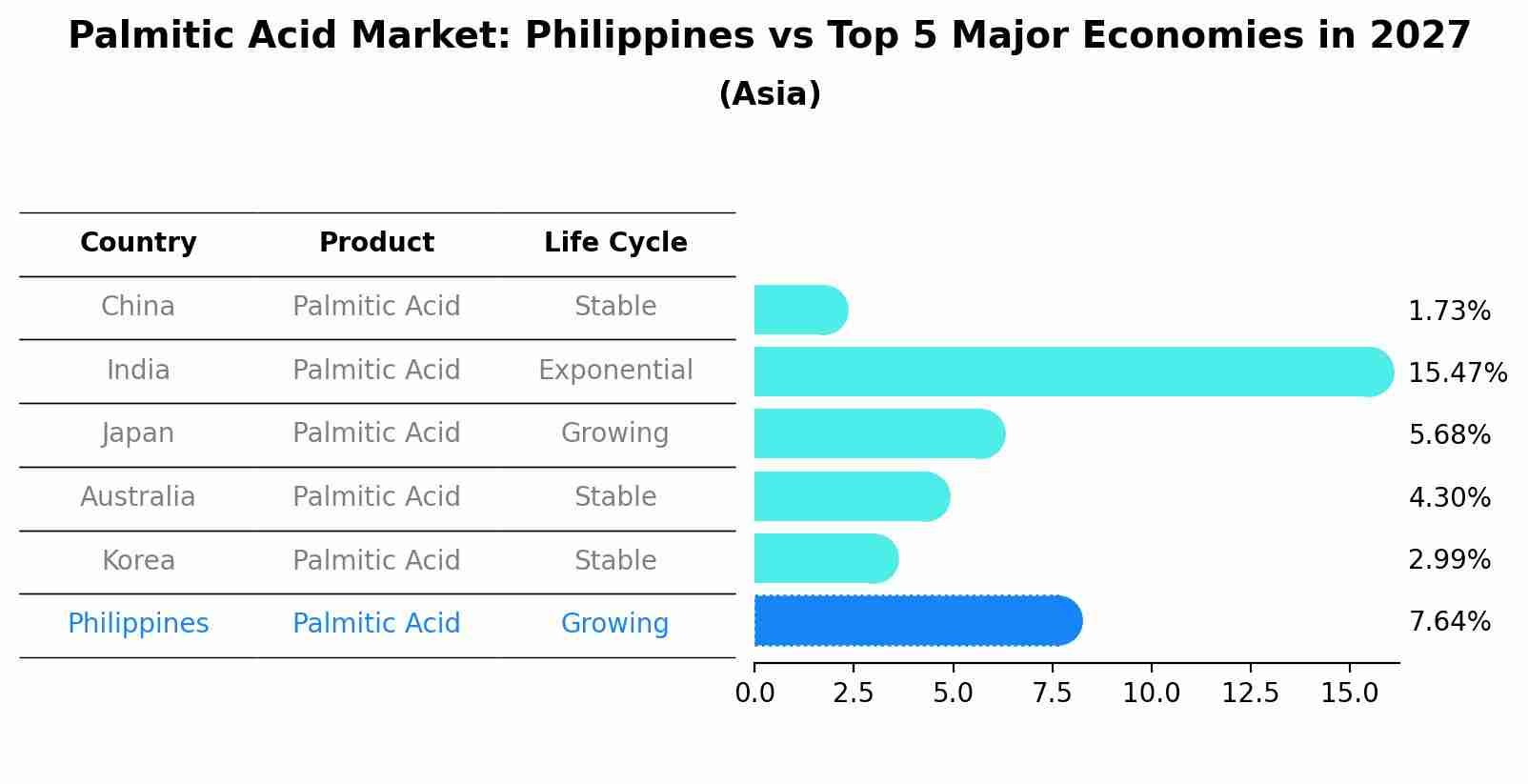Philippines Palmitic Acid Market (2025-2031) Outlook | Analysis, Value, Companies, Growth, Forecast, Share, Size, Industry, Revenue, Trends
| Product Code: ETC336989 | Publication Date: Aug 2022 | Updated Date: Nov 2025 | Product Type: Market Research Report | |
| Publisher: 6Wresearch | Author: Ravi Bhandari | No. of Pages: 75 | No. of Figures: 35 | No. of Tables: 20 |
Philippines Palmitic Acid Market Top 5 Importing Countries and Market Competition (HHI) Analysis
In 2024, the Philippines continued to rely heavily on imports of palmitic acid, with Malaysia, Singapore, Japan, China, and Thailand being the top exporting countries. Despite a high Herfindahl-Hirschman Index (HHI) indicating concentrated market control, the industry experienced a significant negative compound annual growth rate (CAGR) of -16.42% from 2020 to 2024. However, there was a notable rebound in growth in 2024, with a growth rate of 16.0% from the previous year, suggesting a potential shift in market dynamics and opportunities for the industry in the Philippines.

Palmitic Acid Market: Philippines vs Top 5 Major Economies in 2027 (Asia)
In the Asia region, the Palmitic Acid market in Philippines is projected to expand at a growing growth rate of 7.64% by 2027. The largest economy is China, followed by India, Japan, Australia and South Korea.

philippines palmitic acid market Synopsis
With an expected CAGR of around 4%, the Philippines palmitic acid market is set to experience moderate growth. Palmitic acid finds diverse applications, including in the production of cosmetics, food products, and detergents. The expanding consumer goods sector, coupled with changing lifestyles and preferences, drives the demand for products containing palmitic acid. However, market growth may be influenced by factors such as regulatory considerations and the development of alternative ingredients.
Drivers of the Market
The Philippines palmitic acid market shows promising prospects, primarily driven by its applications in the personal care, cosmetics, and food industries. Palmitic acid is widely used in the production of soaps, creams, lotions, and various cosmetics due to its emollient properties. The expanding middle-class population and growing disposable income contribute to the demand for personal care products, thereby bolstering the palmitic acid market. Additionally, its role in the food sector, such as in flavor enhancers and emulsifiers, further propels market growth.
Challenges of the Market
The Philippines palmitic acid market has growth potential, but it faces notable challenges. Fluctuating prices of palm oil, a primary source of palmitic acid, can impact production costs and profitability. Additionally, the market must navigate changing consumer preferences towards healthier alternatives, as palmitic acid is commonly used in the food industry. Finding sustainable sourcing options and diversifying applications beyond the food sector will be essential to overcome these challenges.
COVID-19 Impact on the Market
The Philippines palmitic acid market experienced disruptions due to the Covid-19 pandemic. Fluctuations in raw material availability and transportation issues impacted production and supply. Demand from industries like personal care and food was also influenced by changing consumer preferences during the pandemic. As the situation stabilizes, a recovery in these industries is likely to drive the palmitic acid market.
Key Players in the Market
The Philippines palmitic acid market is likely to witness steady growth in various industries, including food and beverage, personal care, and pharmaceuticals. Emery Oleochemicals Philippines Inc. is a key player in this market.
Key Highlights of the Report:
- Philippines Palmitic Acid Market Outlook
- Market Size of Philippines Palmitic Acid Market, 2024
- Forecast of Philippines Palmitic Acid Market, 2031
- Historical Data and Forecast of Philippines Palmitic Acid Revenues & Volume for the Period 2021-2031
- Philippines Palmitic Acid Market Trend Evolution
- Philippines Palmitic Acid Market Drivers and Challenges
- Philippines Palmitic Acid Price Trends
- Philippines Palmitic Acid Porter's Five Forces
- Philippines Palmitic Acid Industry Life Cycle
- Historical Data and Forecast of Philippines Palmitic Acid Market Revenues & Volume By Type for the Period 2021-2031
- Historical Data and Forecast of Philippines Palmitic Acid Market Revenues & Volume By Distilled Type for the Period 2021-2031
- Historical Data and Forecast of Philippines Palmitic Acid Market Revenues & Volume By Fractionated Type for the Period 2021-2031
- Historical Data and Forecast of Philippines Palmitic Acid Market Revenues & Volume By Application for the Period 2021-2031
- Historical Data and Forecast of Philippines Palmitic Acid Market Revenues & Volume By Soap & Detergent for the Period 2021-2031
- Historical Data and Forecast of Philippines Palmitic Acid Market Revenues & Volume By Cosmetics for the Period 2021-2031
- Historical Data and Forecast of Philippines Palmitic Acid Market Revenues & Volume By Grease & Lubricant for the Period 2021-2031
- Historical Data and Forecast of Philippines Palmitic Acid Market Revenues & Volume By Others for the Period 2021-2031
- Philippines Palmitic Acid Import Export Trade Statistics
- Market Opportunity Assessment By Type
- Market Opportunity Assessment By Application
- Philippines Palmitic Acid Top Companies Market Share
- Philippines Palmitic Acid Competitive Benchmarking By Technical and Operational Parameters
- Philippines Palmitic Acid Company Profiles
- Philippines Palmitic Acid Key Strategic Recommendations
Frequently Asked Questions About the Market Study (FAQs):
1 Executive Summary |
2 Introduction |
2.1 Key Highlights of the Report |
2.2 Report Description |
2.3 Market Scope & Segmentation |
2.4 Research Methodology |
2.5 Assumptions |
3 Philippines Palmitic Acid Market Overview |
3.1 Philippines Country Macro Economic Indicators |
3.2 Philippines Palmitic Acid Market Revenues & Volume, 2021 & 2031F |
3.3 Philippines Palmitic Acid Market - Industry Life Cycle |
3.4 Philippines Palmitic Acid Market - Porter's Five Forces |
3.5 Philippines Palmitic Acid Market Revenues & Volume Share, By Type, 2021 & 2031F |
3.6 Philippines Palmitic Acid Market Revenues & Volume Share, By Application, 2021 & 2031F |
4 Philippines Palmitic Acid Market Dynamics |
4.1 Impact Analysis |
4.2 Market Drivers |
4.2.1 Growing demand for personal care and cosmetics products in the Philippines |
4.2.2 Increasing use of palmitic acid in food and beverage industry for enhancing texture and stability |
4.2.3 Rising awareness about the benefits of palmitic acid in pharmaceutical applications |
4.3 Market Restraints |
4.3.1 Fluctuating prices of raw materials affecting the production cost of palmitic acid |
4.3.2 Stringent regulations regarding the use of palmitic acid in certain industries |
5 Philippines Palmitic Acid Market Trends |
6 Philippines Palmitic Acid Market, By Types |
6.1 Philippines Palmitic Acid Market, By Type |
6.1.1 Overview and Analysis |
6.1.2 Philippines Palmitic Acid Market Revenues & Volume, By Type, 2021-2031F |
6.1.3 Philippines Palmitic Acid Market Revenues & Volume, By Distilled Type, 2021-2031F |
6.1.4 Philippines Palmitic Acid Market Revenues & Volume, By Fractionated Type, 2021-2031F |
6.2 Philippines Palmitic Acid Market, By Application |
6.2.1 Overview and Analysis |
6.2.2 Philippines Palmitic Acid Market Revenues & Volume, By Soap & Detergent, 2021-2031F |
6.2.3 Philippines Palmitic Acid Market Revenues & Volume, By Cosmetics, 2021-2031F |
6.2.4 Philippines Palmitic Acid Market Revenues & Volume, By Grease & Lubricant, 2021-2031F |
6.2.5 Philippines Palmitic Acid Market Revenues & Volume, By Others, 2021-2031F |
7 Philippines Palmitic Acid Market Import-Export Trade Statistics |
7.1 Philippines Palmitic Acid Market Export to Major Countries |
7.2 Philippines Palmitic Acid Market Imports from Major Countries |
8 Philippines Palmitic Acid Market Key Performance Indicators |
8.1 Number of new product launches containing palmitic acid in the Philippines |
8.2 Percentage increase in palmitic acid usage in the food and beverage sector |
8.3 Research and development investments in palmitic acid-based products |
8.4 Adoption rate of palmitic acid in pharmaceutical formulations in the Philippines |
8.5 Number of partnerships and collaborations for palmitic acid distribution and supply chain enhancements |
9 Philippines Palmitic Acid Market - Opportunity Assessment |
9.1 Philippines Palmitic Acid Market Opportunity Assessment, By Type, 2021 & 2031F |
9.2 Philippines Palmitic Acid Market Opportunity Assessment, By Application, 2021 & 2031F |
10 Philippines Palmitic Acid Market - Competitive Landscape |
10.1 Philippines Palmitic Acid Market Revenue Share, By Companies, 2024 |
10.2 Philippines Palmitic Acid Market Competitive Benchmarking, By Operating and Technical Parameters |
11 Company Profiles |
12 Recommendations |
13 Disclaimer |
- Single User License$ 1,995
- Department License$ 2,400
- Site License$ 3,120
- Global License$ 3,795
Search
Thought Leadership and Analyst Meet
Our Clients
Related Reports
- Canada Oil and Gas Market (2026-2032) | Share, Segmentation, Value, Industry, Trends, Forecast, Analysis, Size & Revenue, Growth, Competitive Landscape, Outlook, Companies
- Germany Breakfast Food Market (2026-2032) | Industry, Share, Growth, Size, Companies, Value, Analysis, Revenue, Trends, Forecast & Outlook
- Australia Briquette Market (2025-2031) | Growth, Size, Revenue, Forecast, Analysis, Trends, Value, Share, Industry & Companies
- Vietnam System Integrator Market (2025-2031) | Size, Companies, Analysis, Industry, Value, Forecast, Growth, Trends, Revenue & Share
- ASEAN and Thailand Brain Health Supplements Market (2025-2031) | Strategy, Consumer Insights, Analysis, Investment Trends, Opportunities, Growth, Size, Share, Industry, Revenue, Segments, Value, Segmentation, Supply, Forecast, Restraints, Outlook, Competition, Drivers, Trends, Demand, Pricing Analysis, Competitive, Strategic Insights, Companies, Challenges
- ASEAN Bearings Market (2025-2031) | Strategy, Consumer Insights, Analysis, Investment Trends, Opportunities, Growth, Size, Share, Industry, Revenue, Segments, Value, Segmentation, Supply, Forecast, Restraints, Outlook, Competition, Drivers, Trends, Demand, Pricing Analysis, Competitive, Strategic Insights, Companies, Challenges
- Europe Flooring Market (2025-2031) | Outlook, Share, Industry, Trends, Forecast, Companies, Revenue, Size, Analysis, Growth & Value
- Saudi Arabia Manlift Market (2025-2031) | Outlook, Size, Growth, Trends, Companies, Industry, Revenue, Value, Share, Forecast & Analysis
- Uganda Excavator, Crane, and Wheel Loaders Market (2025-2031) | Strategy, Consumer Insights, Analysis, Investment Trends, Opportunities, Growth, Size, Share, Industry, Revenue, Segments, Value, Segmentation, Supply, Forecast, Restraints, Outlook, Competition, Drivers, Trends, Demand, Pricing Analysis, Competitive, Strategic Insights, Companies, Challenges
- Rwanda Excavator, Crane, and Wheel Loaders Market (2025-2031) | Strategy, Consumer Insights, Analysis, Investment Trends, Opportunities, Growth, Size, Share, Industry, Revenue, Segments, Value, Segmentation, Supply, Forecast, Restraints, Outlook, Competition, Drivers, Trends, Demand, Pricing Analysis, Competitive, Strategic Insights, Companies, Challenges
Industry Events and Analyst Meet
Whitepaper
- Middle East & Africa Commercial Security Market Click here to view more.
- Middle East & Africa Fire Safety Systems & Equipment Market Click here to view more.
- GCC Drone Market Click here to view more.
- Middle East Lighting Fixture Market Click here to view more.
- GCC Physical & Perimeter Security Market Click here to view more.
6WResearch In News
- Doha a strategic location for EV manufacturing hub: IPA Qatar
- Demand for luxury TVs surging in the GCC, says Samsung
- Empowering Growth: The Thriving Journey of Bangladesh’s Cable Industry
- Demand for luxury TVs surging in the GCC, says Samsung
- Video call with a traditional healer? Once unthinkable, it’s now common in South Africa
- Intelligent Buildings To Smooth GCC’s Path To Net Zero


















